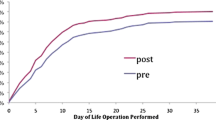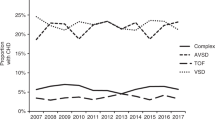Abstract
Neurodevelopmental (ND) impairment is common in children with congenital heart disease (CHD). While routine ND surveillance and evaluation of high-risk patients has become the standard-of-care, capture rate, barriers to referral, and potential patient benefits remain incompletely understood. Electronic data warehouse records from a single center were reviewed to identify all eligible and evaluated patients between July 2015 and December 2017 based on current guidelines for ND screening in CHD. Diagnoses, referring provider, and payor were considered. Potential benefit of the evaluation was defined as receipt of new diagnosis, referral for additional evaluation, or referral for a new service. Contingencies were assessed with Fisher’s exact test. In this retrospective, cohort study, of 3434 children identified as eligible for ND evaluation, 135 were evaluated (4%). Appropriate evaluation was affected by diagnostic bias against coarctation of the aorta (CoArc) and favoring hypoplastic left heart syndrome (HLHS) (1.8 vs. 11.9%, p<0.01). Referrals were disproportionally made by a select group of cardiologists, and the rate of ND appointment non-compliance was higher in self-pay compared to insured patients (78% vs 27%, p<0.01). Potential benefit rate was 70–80% amongst individuals with the three most common diagnoses requiring neonatal surgery (CoArc, transposition of the great arteries, and HLHS). Appropriate ND evaluation in CHD is impacted by diagnosis, provider, and insurance status. Potential benefit of ND evaluation is high regardless of diagnosis. Strategies to improve access to ND evaluations and provider understanding of the at-risk population will likely improve longitudinal ND surveillance and clinical benefit.




Similar content being viewed by others
References
Hoffman JI, Kaplan S (2002) The incidence of congenital heart disease. J Am Coll Cardiol 39:1890–1900
Goldberg CS et al (2014) Factors associated with neurodevelopment for children with single ventricle lesions. J Pediatr 165:490–496. https://doi.org/10.1016/j.jpeds.2014.05.019
Gaynor JW et al (2015) Neurodevelopmental outcomes after cardiac surgery in infancy. Pediatrics 135:816–825. https://doi.org/10.1542/peds.2014-3825
Ringle ML, Wernovsky G (2016) Functional, quality of life, and neurodevelopmental outcomes after congenital cardiac surgery. Semin Perinatol 40:556–570. https://doi.org/10.1053/j.semperi.2016.09.008
Mussatto KA et al (2014) Risk and prevalence of developmental delay in young children with congenital heart disease. Pediatrics 133:e570–e577. https://doi.org/10.1542/peds.2013-2309
Spittle A, Orton J, Anderson PJ, Boyd R, Doyle LW (2015) Early developmental intervention programmes provided post hospital discharge to prevent motor and cognitive impairment in preterm infants. Cochrane Database Syst Rev. https://doi.org/10.1002/14651858.CD005495.pub4
Marino BS et al (2012) Neurodevelopmental outcomes in children with congenital heart disease: evaluation and management: a scientific statement from the American Heart Association. Circulation 126:1143–1172. https://doi.org/10.1161/CIR.0b013e318265ee8a
Knutson S, Kelleman MS, Kochilas L (2016) Implementation of developmental screening guidelines for children with congenital heart disease. J Pediatr 176:135–141.e132. https://doi.org/10.1016/j.jpeds.2016.05.029
Mahle WT, Wernovsky G (2001) Long-term developmental outcome of children with complex congenital heart disease. Clin Perinatol 28:235–247
Oster ME, Watkins S, Hill KD, Knight JH, Meyer RE (2017) Academic outcomes in children with congenital heart defects: a population-based cohort study. Circulation 10(2):e003074. https://doi.org/10.1161/circoutcomes.116.003074
Sanz JH et al (2017) Prevalence and pattern of executive dysfunction in school age children with congenital heart disease. Congenit Heart Dis 12:202–209. https://doi.org/10.1111/chd.12427
Mulkey SB et al (2016) School-age test proficiency and special education after congenital heart disease surgery in infancy. J Pediatr 178:47–54
Simon BV et al (2019) Neurodevelopmental delay following the neonatal repair of coarctation and arch obstruction. Ann Thorac Surg. https://doi.org/10.1016/j.athoracsur.2019.04.088
Soto CB et al (2011) Implementation of a routine developmental follow-up program for children with congenital heart disease: early results. Congenit Heart Dis 6:451–460. https://doi.org/10.1111/j.1747-0803.2011.00546.x
Mussatto KA et al (2015) Risk factors for abnormal developmental trajectories in young children with congenital heart disease. Circulation 132:755–761. https://doi.org/10.1161/circulationaha.114.014521
Spittle AJ et al (2010) Preventive care at home for very preterm infants improves infant and caregiver outcomes at 2 years. Pediatrics 126:e171–e178. https://doi.org/10.1542/peds.2009-3137
Patra K, Greene MM, Perez B, Silvestri JM (2014) Neonatal high-risk follow-up clinics: how to improve attendance in very low birthweight infants. E-J Neonatol Res 4(1):3–13
Michael M, Scharf R, Letzkus L, Vergales J (2016) Improving neurodevelopmental surveillance and follow-up in infants with congenital heart disease. Congenit Heart Dis 11:183–188. https://doi.org/10.1111/chd.12333
Loccoh EC et al (2018) Prevalence and risk factors associated with non-attendance in neurodevelomental follow-up clinic among infants with CHD. Cardiol Young 28:554–560. https://doi.org/10.1017/s1047951117002748
Chorna O et al (2016) Feasibility of a team approach to complex congenital heart defect neurodevelopmental follow-up: early experience of a combined cardiology/neonatal intensive care unit follow-up program. Circulation 9:432–440. https://doi.org/10.1161/circoutcomes.116.002614
Funding
This study was not funded by internal or external funding sources.
Author information
Authors and Affiliations
Corresponding author
Ethics declarations
Conflict of interest
The authors declare that they have no conflict of interest.
Ethical Approval
All procedures performed in studies involving human participants were in accordance with the ethical standards of the institutional and/or national research committee and with the 1964 Helsinki declaration and its later amendments or comparable ethical standards.
Informed Consent
Due to the retrospective nature of the study, there was no direct contact with participants. The data was collected through medical chart review. Informed consent was waived and this waiver was approved by the University of Utah and Primary Children’s Hospital Institutional Review Board.
Research Involving Human and Animal Participants
This article does not contain any studies with animals performed by any of the authors.
Additional information
Publisher's Note
Springer Nature remains neutral with regard to jurisdictional claims in published maps and institutional affiliations.
Rights and permissions
About this article
Cite this article
Glotzbach, K.L., Ward, J.J., Marietta, J. et al. The Benefits and Bias in Neurodevelopmental Evaluation for Children with Congenital Heart Disease. Pediatr Cardiol 41, 327–333 (2020). https://doi.org/10.1007/s00246-019-02260-7
Received:
Accepted:
Published:
Issue Date:
DOI: https://doi.org/10.1007/s00246-019-02260-7




